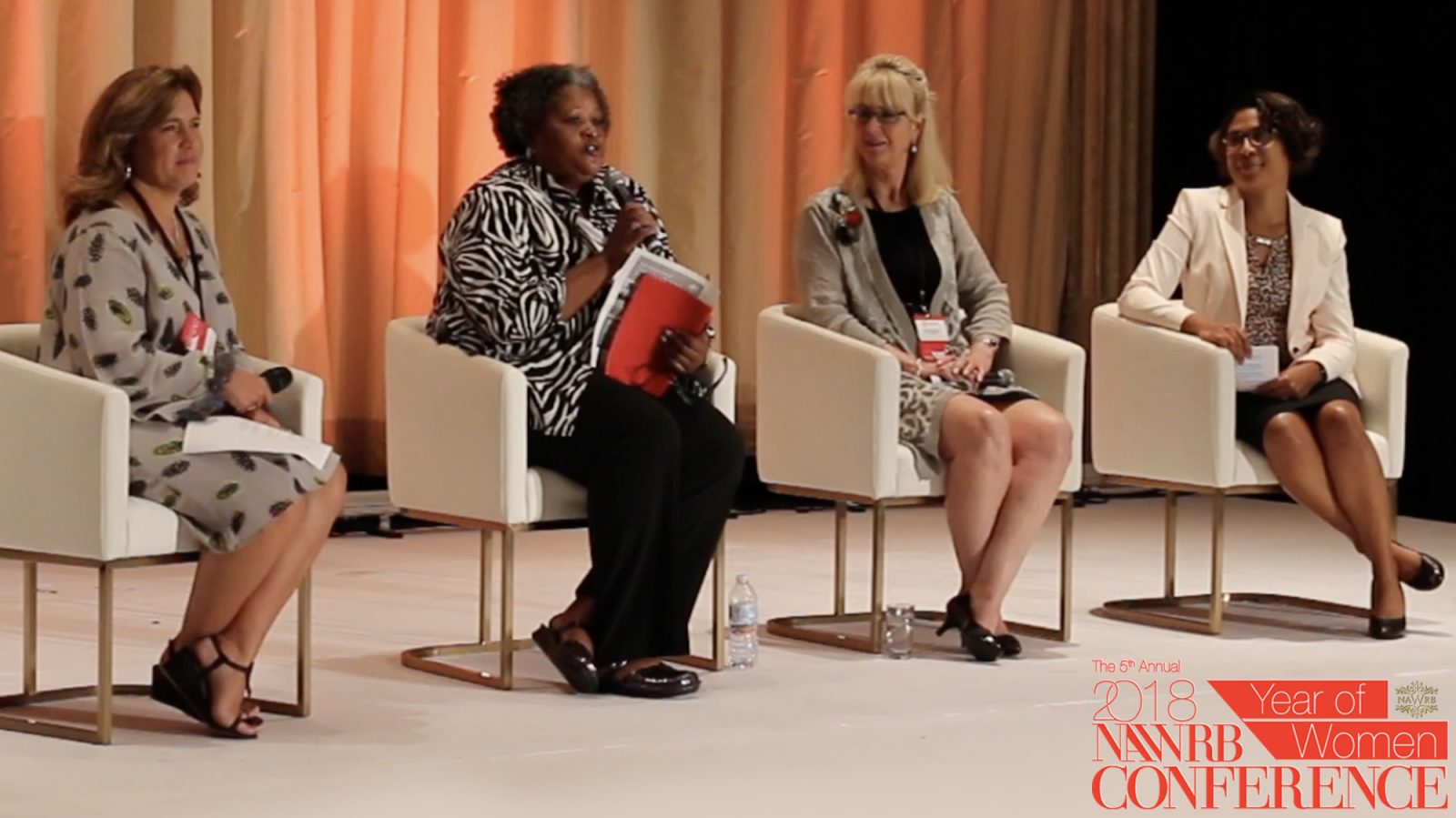Often in the industry, when we think of the forty-eight-year-old Government Sponsored Entity The Federal Home Loan Mortgage Corporation, otherwise known as Freddie Mac, we think: “I’d love to be an REO broker with them” or “I’d love to be in a vendor relationship with them.” However, as we discovered in our “Who is Freddie Mac Today?” presentation, the GSE is way more than meets the eye, staying on the young side of forty-eight with an eye toward innovation and staying current.
With representatives from the REO space, Supplier Diversity, Affordable Housing, and Community Outreach, as well as Affordable Lending, our panelists, all leaders with a collective experience of over fifty years not only spoke on how the latest innovations fit into Freddie Mac’s main goals, but on how those innovations relate to current housing market trends and needs.
Jennifer Meagher, Director, Operations Change Management and REO Operations for Freddie Mac in Dallas along with her senior REO duties, oversees the REO vendor network. However, she jokes with her team about being a “full-time media personality” as she has recorded an album with the girl’s state choir at the Texas state capitol and in the past hosted an Adopt-the-Pet spot every Friday on local TV.
In her twenty-three years with Freddie Mac, Jennifer has seen a lot of change but says the company’s main goals have remained consistent. The company remains focused on providing affordable housing opportunities while preserving neighborhoods and maximizing returns to taxpayers. Jennifer, who moderated the panel passed the mic to Stacey Walker, Director of Housing and Community Outreach adding that they are all supposed to tell the room a fun fact about themselves.
“I don’t have any fun fact,” said Stacey causing the room to erupt in laughter. In addition to her role in NAWRB as an NDILC member, Stacey has been with Freddie Mac for twenty-six years and is primarily responsible for relationships with the hundreds of housing counseling agencies across the country. Her team manages Freddie Mac’s CreditSmart financial capability curriculum, working with everyone except for lenders. Finally, she relented on the fun fact front—revealing her excitement for an upcoming third Disney Cruise.
She next turned it over to Sandra Heidinger, one of Freddie Mac’s Affordable Lending Managers. Sandra’s team often collaborates with Stacey’s team, helping to get nonprofits involved if needed and assisting in meeting goals while simultaneously helping the consumer. Specifically, she conducts outreach and teams up with lender and real estate partners across the country, to create initiatives and develop strategies. “I’m a certified wino. I have a certificate to prove it,” she deadpanned, causing the audience to erupt in laughter for a second time as she explained that means she is working on her Sommelier (wine expert) certification.
Tomenci Waller-Day, Director of the Supplier Diversity program at Freddie Mac introduced herself and defined her team’s role as working with small-businesses, both women-owned and diverse-owned to act as a liaison, helping them secure more opportunities to do business with the GSE.
“Our goals are centered around our sourcing efforts, outreach efforts as well as development,” she said going on to emphasize the development aspect as it’s a shift in how corporations are approaching Diversity & Inclusion in the supply chain.
In the seven years she has been in her current position and in the twelve overall she has spent in supplier diversity, Tomenci has seen positive growth in women-owned and diverse-owned businesses throughout the nation. When not working in Supplier Diversity for Freddie Mac, she loves to vacation in the Florida Keys with her husband. An upcoming trip will be the fourth one in which they have hopped in a car driving from area to area, turning into “beach bums” in the process.
Advancing Consumer Education and Underserved Markets
Stacey Walker began the conversation with an interesting look into Duty to Serve. In the twenty-three out of twenty-six years she has been working in the affordable housing space, Freddie Mac has never taken a look at underserved markets like this before. Duty to Serve is a regulation that has been on the books for quite a while, but it had been buried in larger legislation when the FHFA mandated both Fannie Mae and Freddie Mac to take a closer look at it and prepare a plan to meet targeted goals by January 2018.
The main goal of Duty to Serve is to scrutinize markets that have historically not been serviced by the GSE and reevaluate to see how service can be increased in those areas by improving manufactured housing, increasing service to rural areas and promoting affordable preservation.
When Freddie Mac took a look at rural areas that have had persistent poverty for 30 years or more, Stacey traveled to some of these areas discovering that many of these communities are lacking in infrastructure and have an abundance of payday loan centers, unscrupulous brokers, and are lacking in resources.
Her team then spent 2017 laying the groundwork and conducting research, so they wouldn’t make rash decisions as every area in the country is not like the other. It was an eye-opening and exciting time for the company, Stacey said.
Housing outreach is also a big part of what Freddie Mac does and they see a need for more education as people who were negatively impacted by the housing crisis are now ready to enter the homebuying market but might be nervous about and want to be further educated.
One of the ways Freddie Mac educates the consumer is through their financial literacy curriculum, CreditSmart. The eighteen-year-old program is getting an update to its platform in order to become more mobile friendly, especially since they have upwards of 10,000 people going online to access information. They aim to have the content revision done by 2019.
Finally, they are increasing their Train-the-Trainer program, designed to educate industry professionals on Freddie Mac’s curriculum. They increased the number of times they engage in that training from two to three times a year and for the first time, will be introducing the program in Spanish. Housing industry professionals can also access free webinars by going to http://www.freddiemac.com/singlefamily/housingpros/ and registering for their Housing Professionals Resource Center.
And realtors can access training at http://www.freddiemac.com/realestatepros. Both websites are regularly updated with policy changes and notices.
Finally, Stacey said that Freddie Mac is researching the 42 million people who are estimated to have thin credit files and along with industry partners will be figuring out ways to reach these people, many of whom are women. Additionally, the GSE has been approached by organizations like MANA and WISER who are looking for ways to educate their members on how to budget for retirement as both groups noticed an increase in the number of women who don’t have enough money to last them going into retirement age.
Innovating for Consumers
Sandra Heidinger likes the idea of a real estate and housing ecosystem because according to her, Freddie Mac cannot create products in a bubble. They work closely with trade associations across the country including real estate groups, lender partners, and nonprofits that have have their ear to the ground. Additionally, they do a lot of “test and learns” in the affordable lending space with customers to see what may work—doing things on a smaller scale before rolling it out on a larger one.
She highlighted Freddie Mac’s Home Possible product offering, a low-down payment mortgage option income-delineated at 100% of area-median income. This option offers low down payments, in some cases as low as 3% for low-to-moderate income homebuyers or those in “high-cost or underserved communities.”
Many people think their only option is to go through the FHFA, however, through Home Possible, the client can use the 3% down payment with a mortgage insurance premium but once that insurance naturally amortizes down to 78% it will automatically drop off, and if the borrower is in a market where the prices are appreciating, they can always call their servicer about having it eliminated it sooner.
For the borrower where income exceeds AMI, a new product was introduced this summer called HomeOne mortgage. With this program, borrowers can receive a 97% loan as a first-time homebuyer with no income or geographic restrictions.
Using Freddie Mac as a Resource to Grow Your Business
“I’m going to get on my soapbox a little bit because a lot of what has been said over the last two days I’m going to reemphasize,” said Tomaneci Waller-Day, going on to say that “It’s not enough as a small business owner to understand your own business but you have to understand the market at the local, regional and national level.” This concept brings to mind Tami Bonnell of EXIT Realty’s SHETalk earlier at the conference in which she introduced the idea of looking at your business from the street level, and at 2,000 and 3,000 foot level views.
Knowing key market data is the key to growing your business Waller-Day said. “This should be the info you live and breathe,” she told us, and Freddie Mac can be a great resource. Every week on their economic page they publish findings on the housing marketplace and post links that lead to economic impact studies groups like Millennials, 30+ groups and women.
The REO space, for example she pointed out, is not the same as it was ten years ago and it’s most likely not going to be the same ten years from now. You have to evolve with the market because people are seeking new and innovative ways their customers can approach it and you want to be at the forefront of those innovations as a business owner.
For real estate and housing professionals especially, it’s important to understand why companies like Freddie Mac are establishing programs like Duty to Serve or why they are making a shift in a particular direction. Knowing this information will turn you into a trusted advisor to your clients, going beyond thinking of them during buying and selling transactions. When you become known as a trusted advisor, she concluded, clients will start to direct new people to you.
From outreach to education, our panelists underlined the role Freddie Mac plays in educating both professionals within the housing and real estate ecosystem as well as the consumer. As many people who aren’t mortgage ready are contending with basic issues like transportation and job placement, Freddie Mac looks to the future, not only through its own programs but by forming strategic alliances and community-based partnerships that can offer people workshops and resources.

 Login
Login


